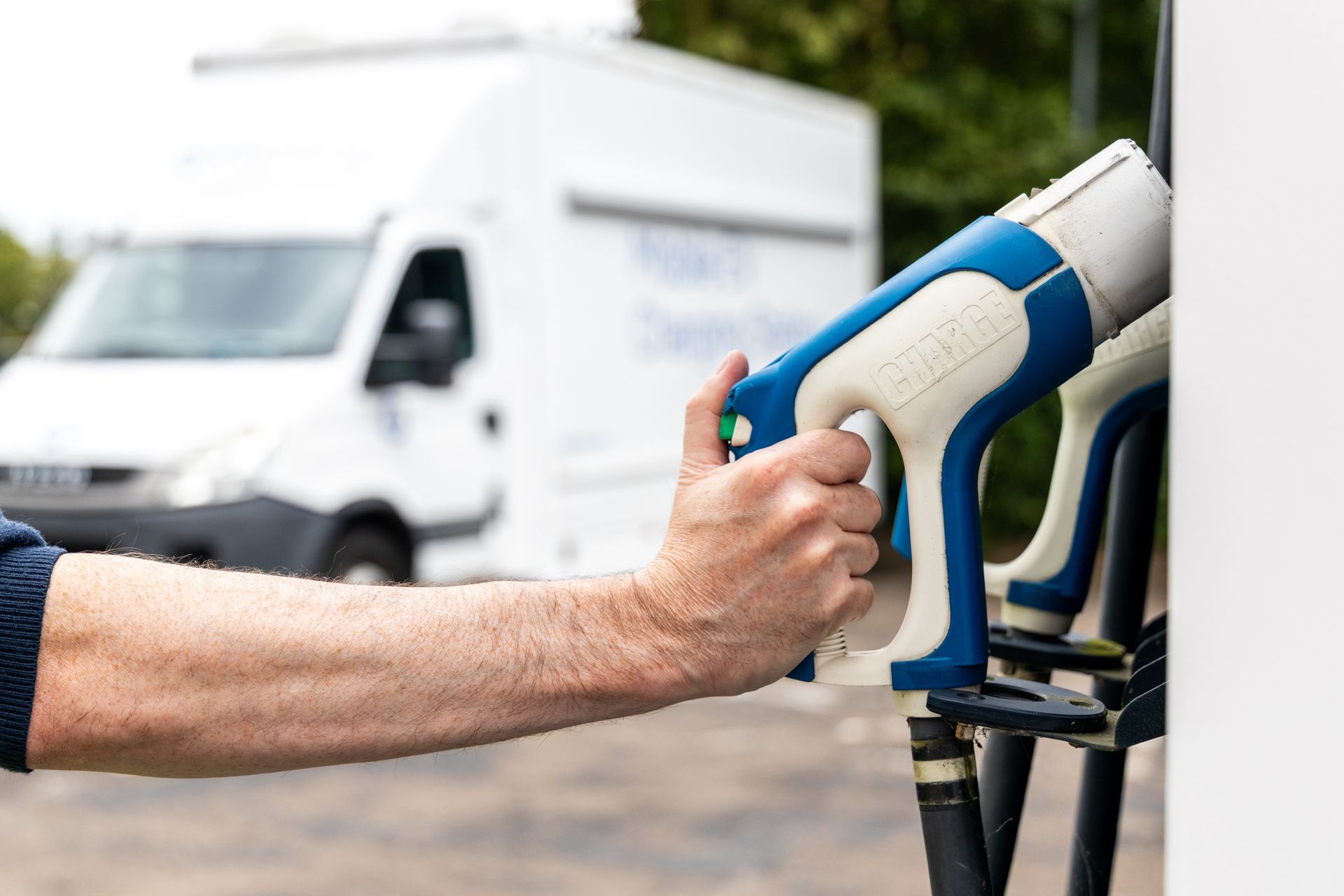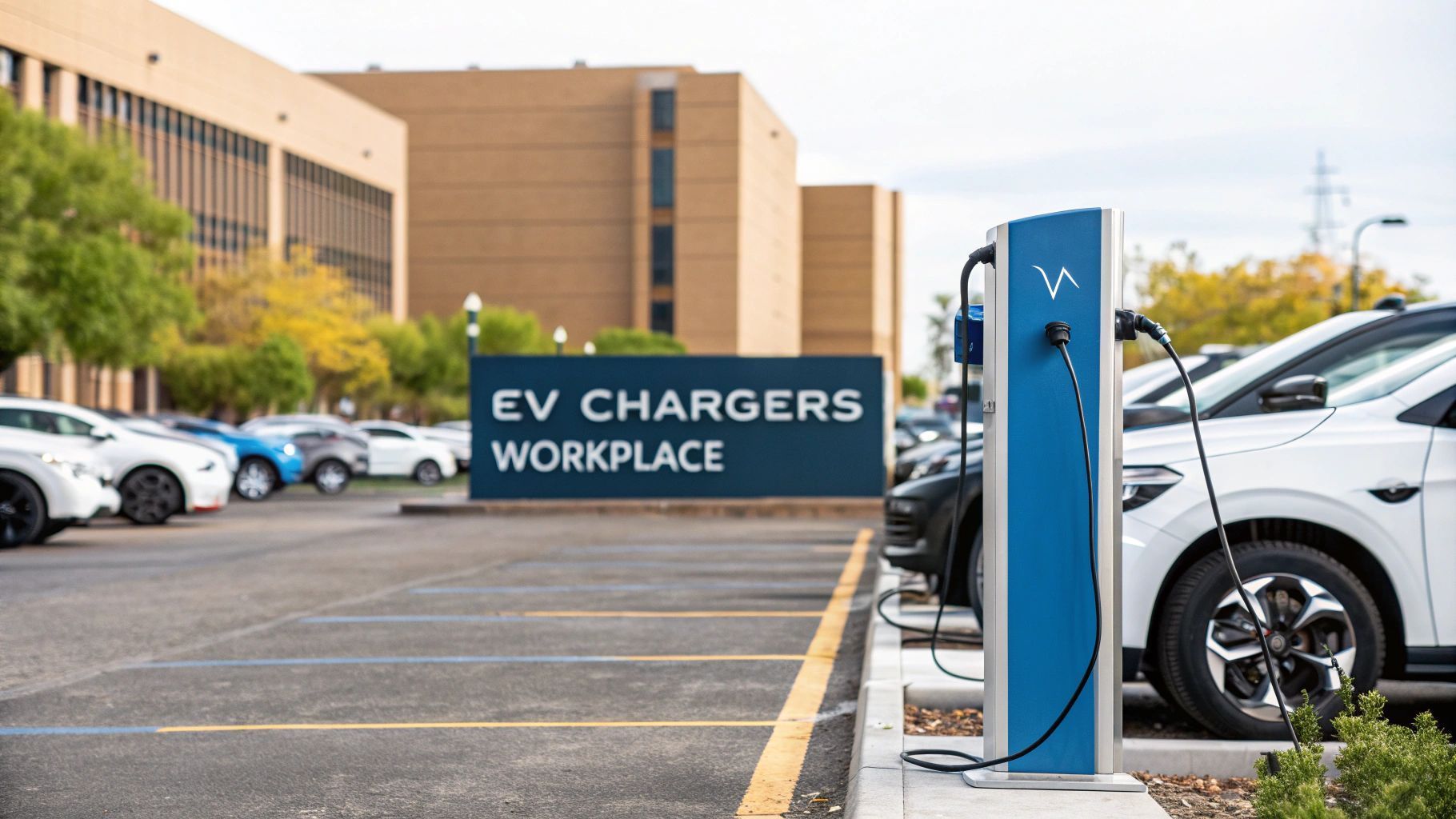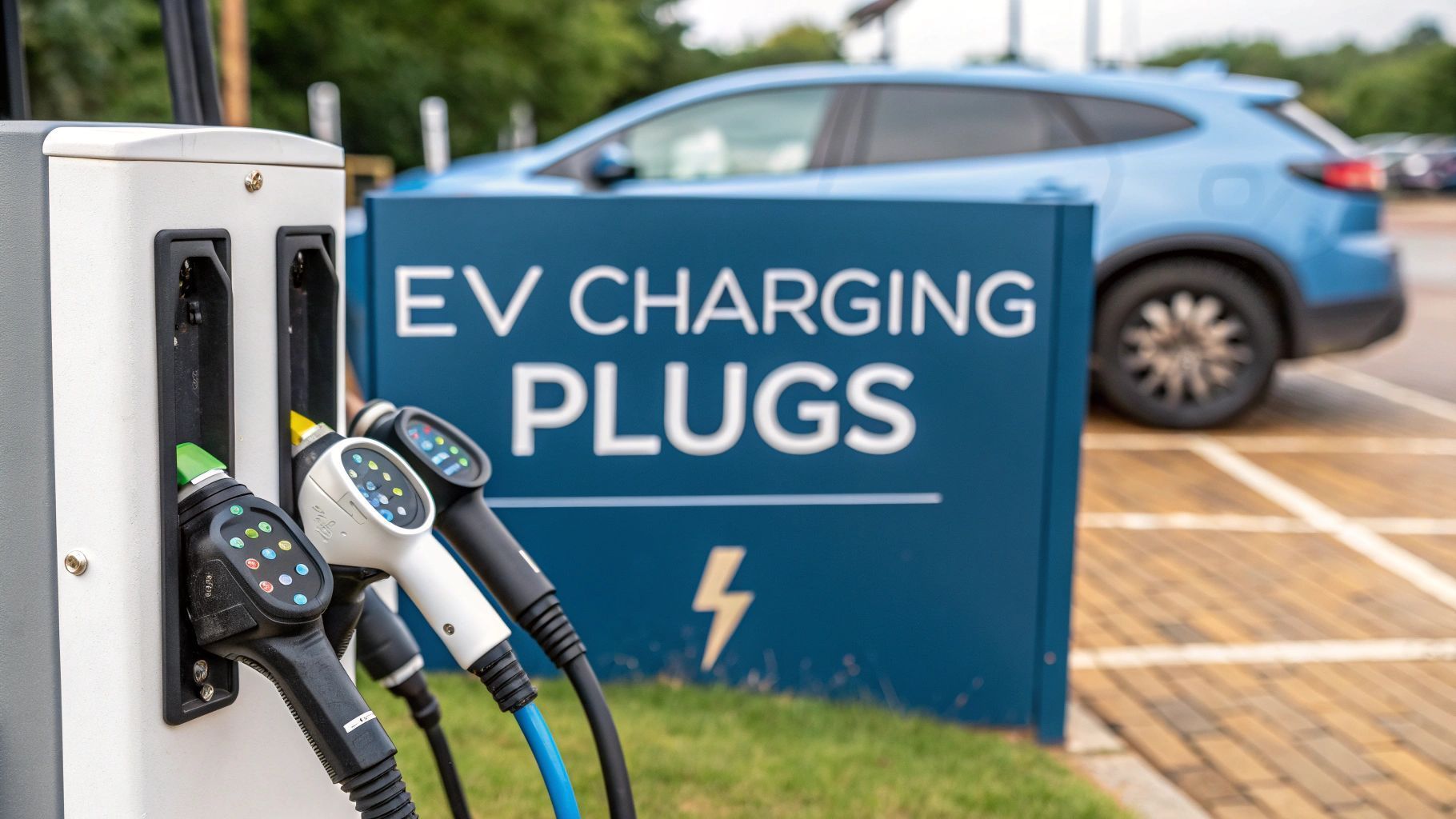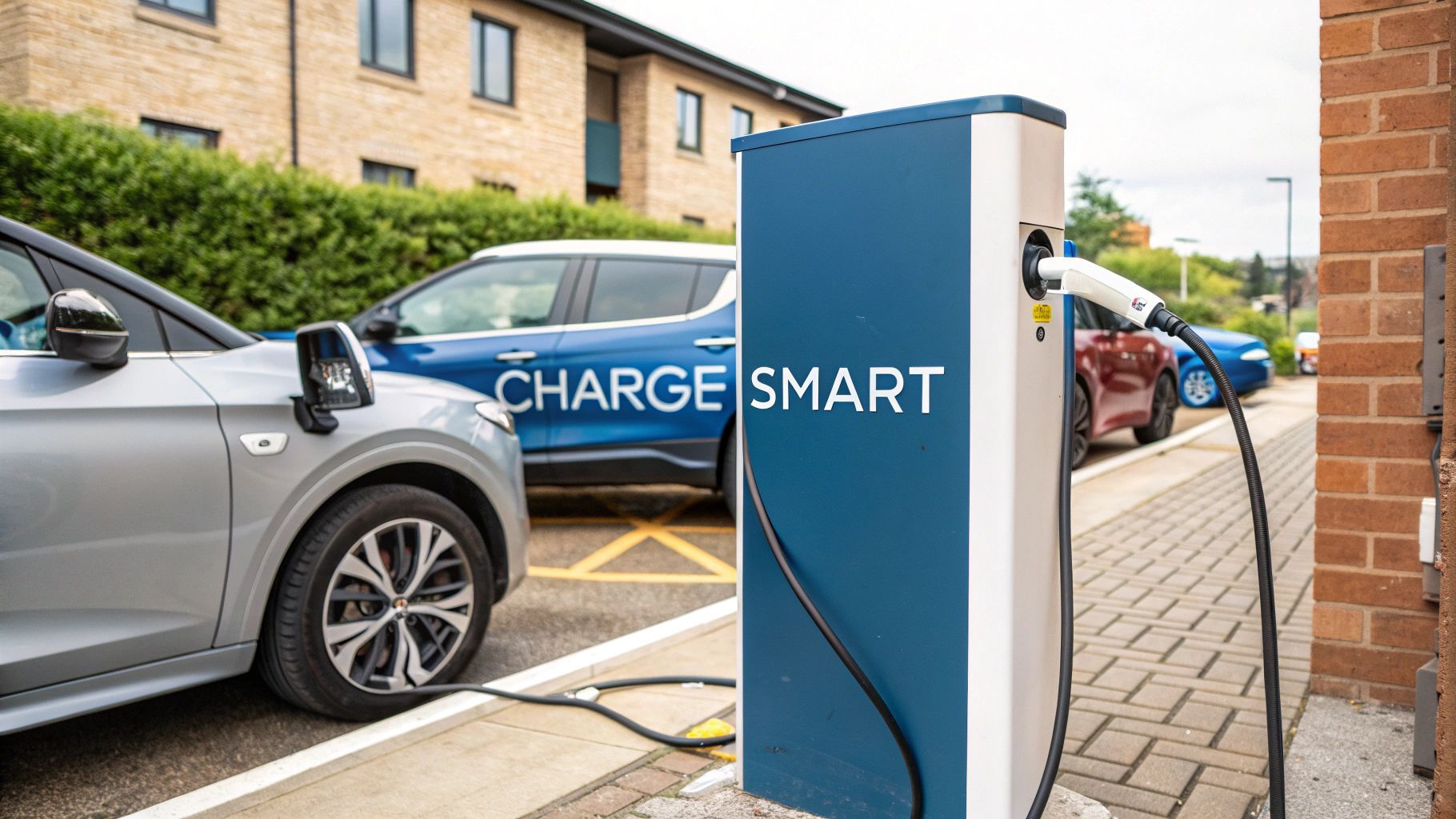Fast Charging Electric Vehicles: Boost Your Revenue
The UK's love affair with electric vehicles is picking up speed but our fixed charging network is struggling to keep up. It is a classic case of demand outstripping supply and it is creating real headaches for drivers and businesses—from nagging range anxiety to the eye-watering cost of installing new charge points.
But what if the solution was not fixed in place? What if it could come to you? This is where flexible, mobile charging comes in, offering a vital—and profitable—way forward.
The Growing Demand for Faster EV Charging
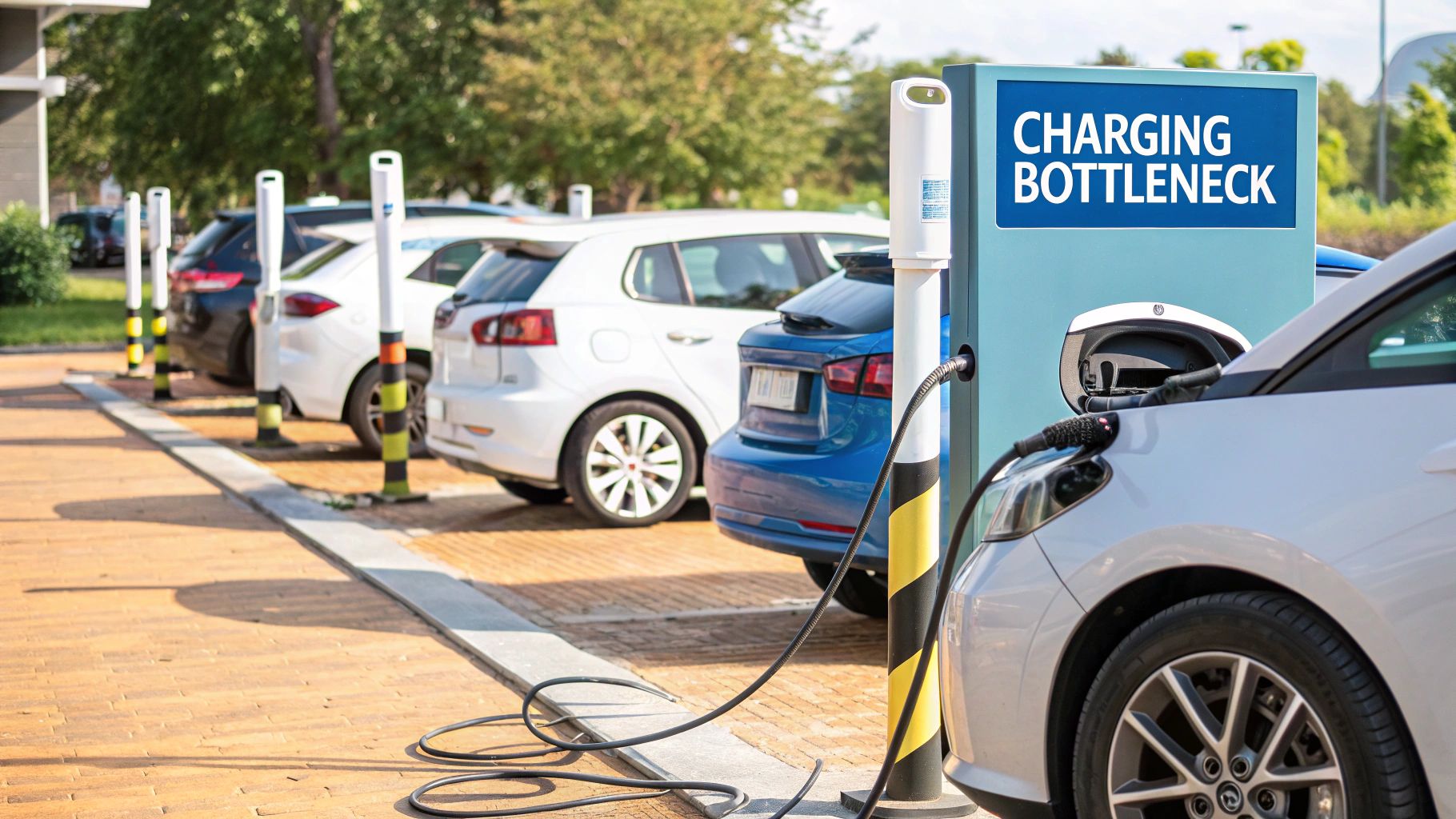
As the UK shifts gears towards electric mobility, the need for fast, accessible charging has never been more urgent. The days of being content with a slow overnight charge are numbered. Today’s EV drivers expect to top up their batteries in minutes, not hours, putting immense pressure on the current infrastructure.
To be fair, the public charging network has grown significantly. As of 1 July, there were 82,002 public charging devices dotted across the country—that is a 27% jump from the previous year. Of those, a respectable 16,677 are rapid chargers delivering 50kW or more, directly tackling the demand for speed. You can dive into the full government analysis on EV charging infrastructure statistics for a closer look.
The Problem with Fixed Infrastructure
Despite this growth, relying solely on fixed charging stations comes with a hefty dose of challenges. For businesses wanting to electrify their fleets or property owners looking to offer charging as an amenity, the hurdles can feel insurmountable.
These fixed solutions create real opportunities for mobile alternatives.
A few key barriers stand out:
- High Upfront Costs: Installing permanent rapid chargers is a serious investment. It often demands expensive grid upgrades and civil engineering works that can run into the tens of thousands of pounds.
- Planning Permission Delays: Getting the green light from local authorities can be a painfully slow and frustrating ordeal, holding up projects for months, sometimes even years.
- Location Inflexibility: Once a charger is in the ground, it is there for good. This rigidity makes it impossible to adapt to changing traffic patterns or serve temporary hotspots like festivals, construction sites or special events.
These limitations shine a spotlight on a clear gap in the market. The fixed network simply does not have the agility to support the UK's dynamic and fast-evolving EV landscape.
The Mobile Charging Opportunity
This is where the real potential for savvy entrepreneurs and forward-thinking businesses emerges. Mobile fast charging electric vehicles offers a powerful alternative that neatly sidesteps the costs and complexities of fixed installations.
Imagine being able to deploy a high-speed charging service exactly where and when it is needed most. This flexibility opens up a world of profitable use cases, from providing emergency roadside assistance for stranded EVs to setting up temporary charging hubs at sold-out concerts.
For a mobile charger operator, the revenue potential is huge. You are not just providing a service; you are turning the limitations of the national grid into a lucrative business advantage.
Getting to Grips with Fast Charging Speeds and Standards
To really see the opportunity in mobile charging, it helps to understand the tech that makes it all tick. Do not worry, you do not need an engineering degree. The world of fast charging electric vehicles really boils down to one simple difference: Alternating Current (AC) versus Direct Current (DC).
Think of it like this. AC charging, the kind you would have at home, is like filling a swimming pool with a garden hose. It is steady, reliable and gets the job done overnight. DC fast charging, on the other hand, is the fire hose. It blasts a huge amount of power directly into the battery, getting you topped up in a fraction of the time.
This distinction is everything. For a business, speed is what unlocks profitability. Being able to recharge a vehicle in minutes instead of hours is a complete game-changer.
Turning Kilowatts into Real-World Range
When we talk about charging speed, the main unit of measurement is the kilowatt (kW). The higher the kW number, the faster the energy flows into your vehicle’s battery. If you want to get into the nuts and bolts of it, you can learn more about how to calculate a kilowatt-hour and what it means for energy use.
But for a driver on the road or a business owner managing a fleet, kilowatts are just numbers. What really matters is the outcome: how many miles of range can I add in a certain amount of time? This is the true measure of a charger’s value.
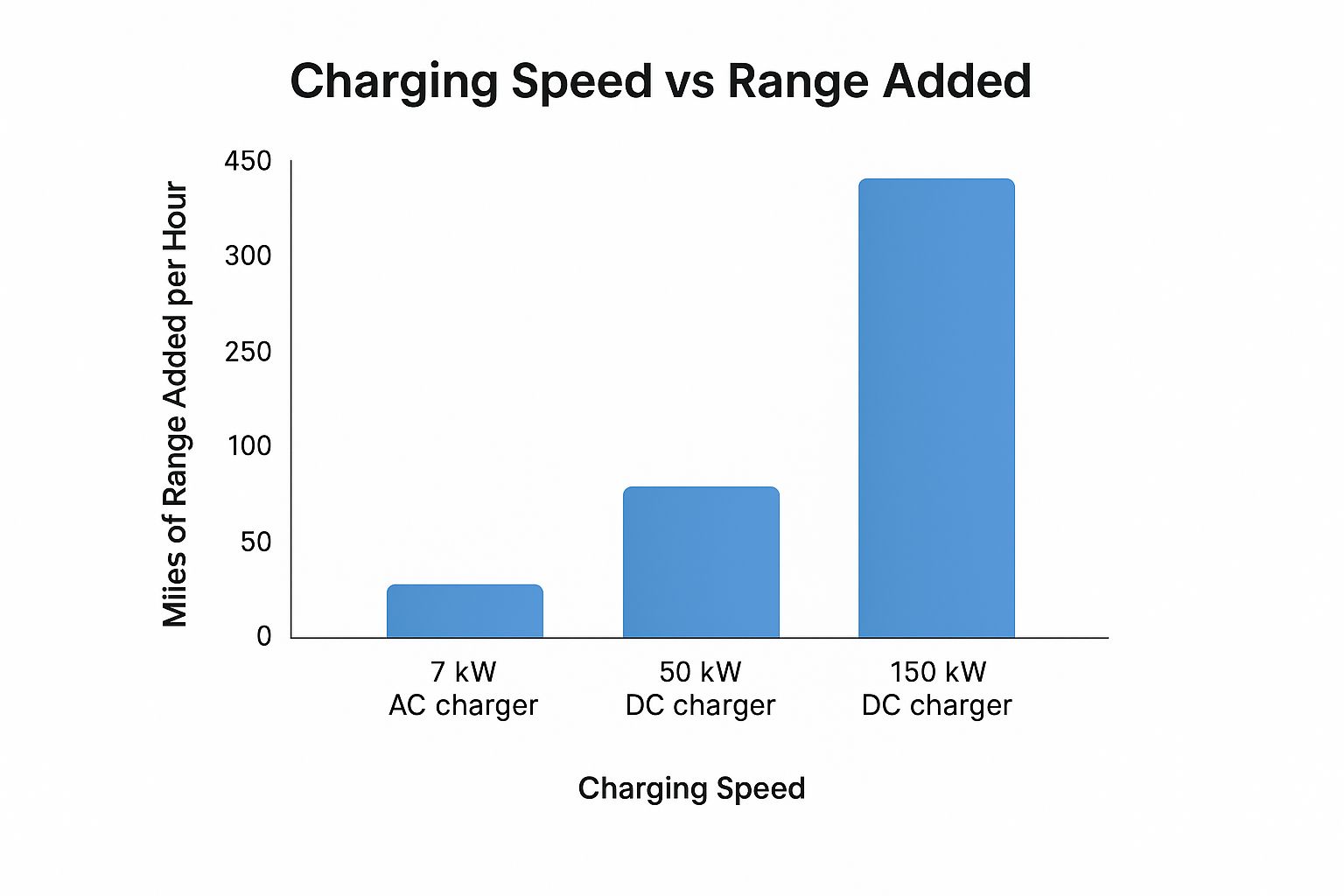
As the infographic shows, jumping from a standard 7 kW home charger to even a modest 50 kW DC unit is a massive leap. It boosts the range you can add in an hour by more than six times, making it a far more practical option for anyone on the move.
The table below breaks down the different charging levels so you can see exactly how power output translates into time saved.
EV Charging Speeds Explained
| Charger Type | Typical Power (kW) | Approx. Time to Add 100 Miles |
|---|---|---|
| Level 1 (AC) | 1-3 kW | 20+ hours |
| Level 2 (AC) | 7-22 kW | 4-8 hours |
| Level 3 (DC Fast) | 50-150 kW | 20-40 minutes |
| Level 3 (DC Ultra-Fast) | 150-350+ kW | 10-20 minutes |
As you can see, DC fast charging is in a league of its own, making it essential for commercial use and for drivers who cannot afford to wait around.
The UK's Go-To Charging Standard
Thankfully, here in the UK and across Europe, the charging landscape has become much less complicated. While you might still see older standards like CHAdeMO on some vehicles, the vast majority of modern EVs use the Combined Charging System (CCS) for their rapid DC charging needs.
The CCS connector is now the standard for almost all new EVs sold in the UK. This standardisation is vital as it means a single type of mobile fast charger can service nearly every modern electric vehicle on the road, from commercial vans to passenger cars.
This widespread adoption of CCS makes life so much easier for a mobile charging business. You do not have to carry a confusing array of different plugs or worry about vehicle compatibility. By focusing on the CCS standard, you can serve the biggest slice of the EV market with one simple, efficient solution. It makes investing in mobile fast charging electric vehicles a refreshingly straightforward business decision.
Pinpointing Gaps in the Fixed Charging Network
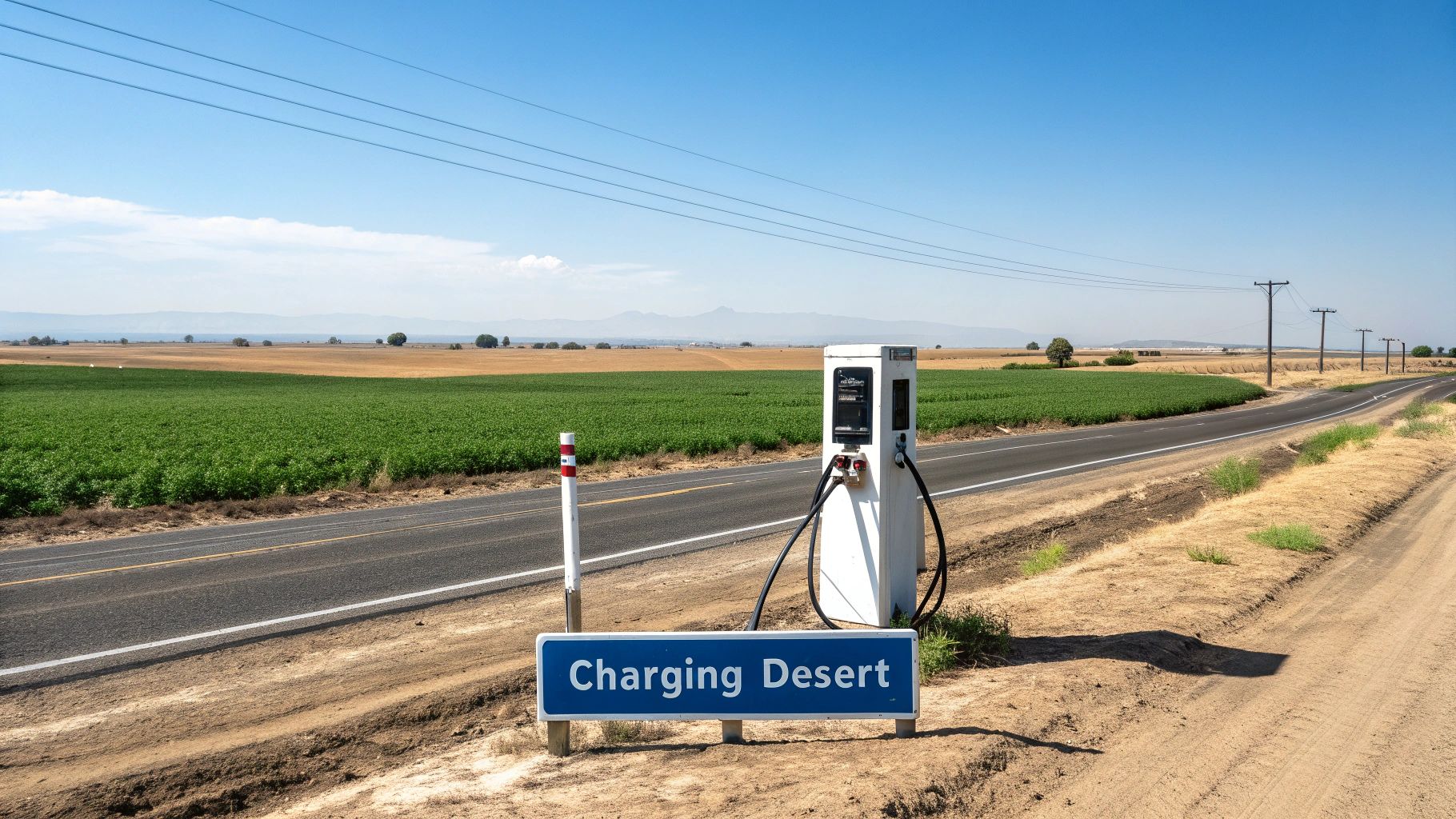
On paper, the growth of the UK's charging network looks impressive. But scratch beneath the surface and you will find some serious weak spots that frustrate drivers and hamstring the country’s EV transition.
These are not just minor inconveniences. They are fundamental flaws in the fixed network model—gaps that mobile charging is perfectly placed to fill.
The most glaring issue is how unevenly the infrastructure is spread out. While the total number of chargers keeps climbing, with 20% of all UK public devices now being high-powered ( 50 kW or more), their location is another story entirely. A massive 54% of chargers are slow, legacy units and the UK’s charger density per person still trails behind many European neighbours. If you want the full picture, the government's own statistics on EV charging infrastructure paint a clear one.
This imbalance has created a very real problem: ‘charging deserts’.
The Problem of Charging Deserts
Charging deserts are exactly what they sound like—areas where public chargers are so scarce that EV drivers are left stranded. You will find them all over the country, especially in places like:
- Rural Communities: For traditional operators, installing expensive rapid chargers in sparsely populated areas just does not make commercial sense.
- Tourist Hotspots: Think national parks or coastal towns. They get flooded with EVs during peak season but lack the year-round infrastructure to cope.
- Urban Blackspots: In many city centres, installing new charging stations is a logistical nightmare thanks to listed buildings, narrow streets or a lack of available space.
These deserts do not just cause range anxiety; they represent a completely untapped market. A family visiting the Peak District for the weekend or a delivery driver servicing a remote village cannot rely on the fixed network. They still need a charge.
The Reliability and Cost Crisis
It is not just about where the chargers are. It is about whether they work and what they cost. How many times have you heard stories of drivers pulling into a motorway service station only to find the chargers are out of order or there is a massive queue for the one that is actually working? This unreliability is poison for driver confidence.
Then there is the cost for those looking to install them.
For businesses and landowners, the economic hurdles to installing fixed fast charging electric vehicles infrastructure are huge. The process is bogged down by eye-watering grid upgrade costs, endless red tape to secure planning permission and hefty ongoing maintenance bills.
When you add it all up—the geographical deserts, the poor reliability and the prohibitive costs—it is clear that a different approach is needed. For all its strengths, the fixed network is too slow, too expensive and too rigid to meet the country's needs on its own.
This is exactly where the flexibility of mobile charging shines. It is not just a nice-to-have; it is becoming an essential service, plugging the gaps that static infrastructure simply cannot reach.
Introducing Mobile Charging: The Flexible Solution
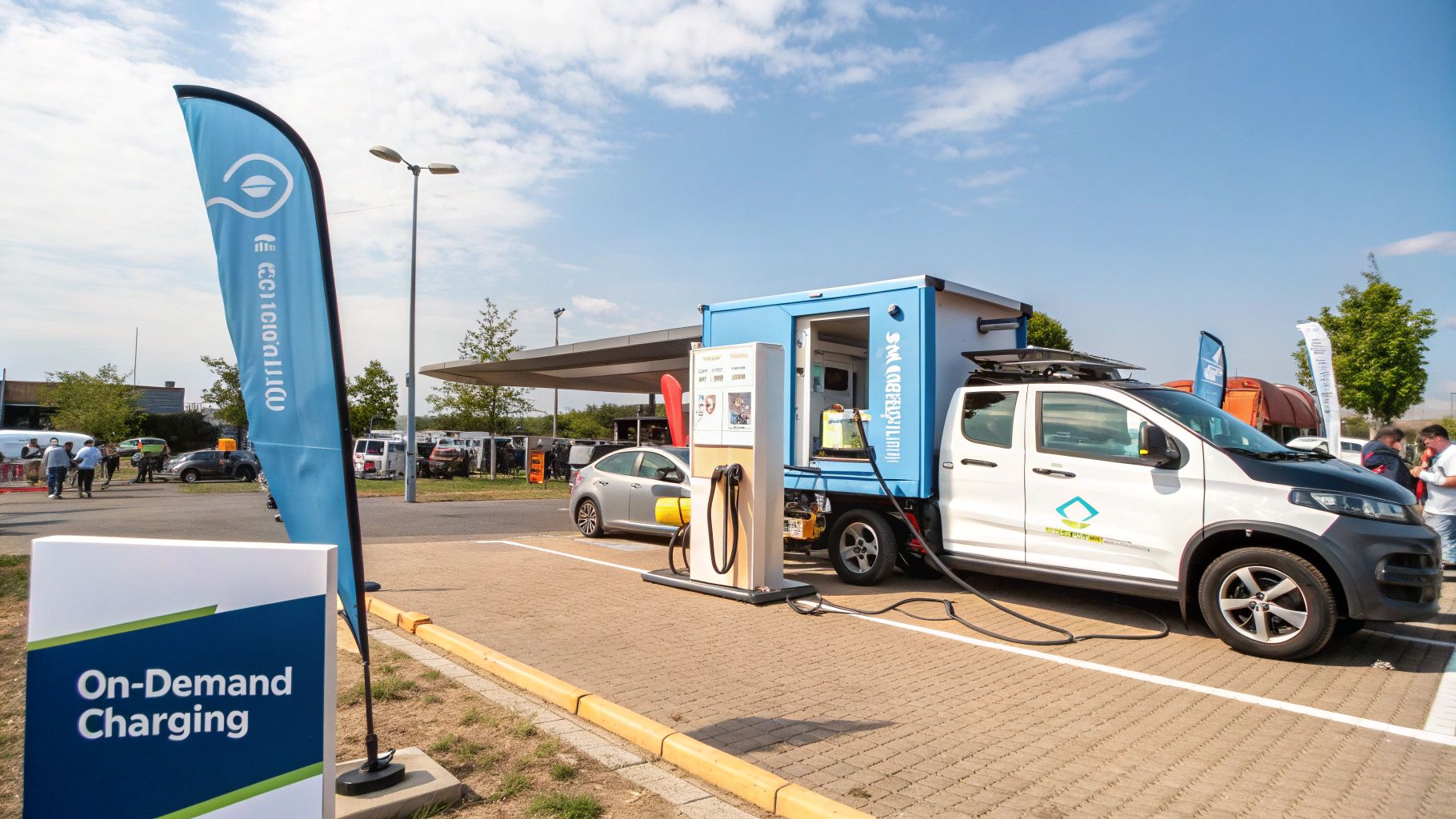
This is where the real opportunity for savvy operators lies. While the fixed charging network is grappling with high costs and logistical headaches, mobile charging units are stepping in as a nimble and powerful alternative. These are not just oversized power banks; they are sophisticated pieces of kit capable of delivering true DC fast charging electric vehicles exactly where the demand is highest.
Mobile charging's greatest advantage is its ability to be deployed almost instantly, anywhere. This sidesteps the lengthy planning permission battles and ruinously expensive grid connection upgrades that plague fixed installations. For an operator, this means you can have a charging service up and running in days, not months or years.
This agility opens up a world of highly profitable scenarios. An operator can generate significant revenue by addressing immediate charging needs that the fixed network simply cannot reach.
Where Mobile Charging Wins
The sheer versatility of mobile charging allows an operator to become a problem-solver for a huge range of clients. This flexibility is its greatest strength and the key to its earning potential. For instance, a mobile charging service can be deployed to support:
- Emergency Roadside Assistance: Offering a vital lifeline to EV drivers who have run out of charge far from a static point. This is a premium service that can command higher prices.
- Commercial Fleet Depots: Many businesses want to electrify their fleets but do not have the on-site infrastructure. A mobile charger can provide daily top-ups, ensuring vehicles are always ready for the next shift.
- Events and Festivals: Large gatherings create temporary charging blackspots. You can set up a pop-up charging hub, serving hundreds of attendees and generating significant income over a single weekend.
- Seasonal Tourist Hotspots: Coastal towns and rural attractions see a massive influx of EVs during holiday periods. A mobile unit can meet this peak demand without needing permanent, year-round infrastructure.
The core business advantage of mobile charging is its ability to take supply directly to the point of demand. An operator is not waiting for customers to find them; they are actively going to where the customers are, maximising the charger’s utilisation and profitability.
Maximising Your Revenue Streams
An operator of a mobile charger has a distinct advantage over fixed charge point owners. You are not just selling electricity; you are selling convenience and accessibility, something customers are more than willing to pay a premium for. The profit model is both straightforward and attractive.
You can purchase electricity at low off-peak rates to charge your mobile unit, then sell that energy at a competitive but profitable price during peak hours. Your ability to move your asset means you can target the most lucrative locations at the most opportune times.
This dynamic approach ensures a much quicker return on investment compared to a fixed charger, which might sit unused for long periods. You can explore a detailed breakdown of the possibilities in our complete UK mobile EV charging service guide to see exactly how the numbers stack up.
The Business of Mobile Charging and Your Earning Potential
Beyond the clever technology and day-to-day flexibility, a mobile charging business is built on a simple yet incredibly powerful financial model. This is where a piece of equipment does not just sit there—it becomes a hard-working, profitable asset. By neatly sidestepping the huge costs and headaches of installing fixed infrastructure, your path to generating real revenue is much clearer and faster.
At the heart of your earning potential is a concept called energy arbitrage . Put simply, this means you can recharge your mobile unit with cheap, off-peak electricity at home or a depot and then sell it at a premium when and where demand is high. It is this basic principle that forms the foundation of a surprisingly lucrative business, whether you are servicing a local commercial fleet or setting up shop at a busy retail park on a Saturday.
Your profitability really comes down to a few key variables, all of which are firmly within your control. Success is all about strategically managing your costs and pricing your service in a way that reflects the convenience you are offering.
Building Your Business Model
The most straightforward approach is a simple price-per-kilowatt-hour (kWh) structure. You decide on a rate that comfortably covers your own electricity costs and leaves you with a healthy profit margin. This model is refreshingly transparent for customers and dead simple for you to manage.
A few key factors will shape your daily income:
- Number of Daily Charges: The more vehicles you can service, the more you earn. It is that simple. Targeting high-traffic areas or locking in contracts with fleet operators is the quickest way to build a steady income stream.
- Cost of Recharging: Your biggest operational expense, by far, is the electricity needed to charge your unit. Recharging your mobile unit overnight at off-peak rates (which can be under 15p per kWh ) dramatically slashes your costs and boosts your margins.
- Pricing Strategy: A typical public rapid charger costs drivers anywhere between 60p and 80p per kWh . As a mobile operator offering a premium, on-demand service, you can price competitively within this range—or even slightly higher—and still provide fantastic value for the convenience.
By getting these elements right, you create a business with seriously low overheads and the potential for high returns. To really get into the weeds on this, we have put together a complete guide exploring the economics of mobile EV charging with a deep dive into ZAPME's model .
Analysing Your Profitability
Let's walk through a practical scenario to see how the numbers actually stack up. Imagine you are operating a mobile unit capable of delivering several decent charges a day.
A mobile operator can achieve a far greater return on investment than a fixed charging station owner. By actively seeking out customers and deploying the service where it is most needed, the asset is constantly working and generating revenue rather than waiting passively for drivers to arrive.
Consider these two very common scenarios for your mobile fast charging electric vehicles service:
- Servicing a Commercial Fleet: You secure a contract to provide daily top-ups for a local delivery company. This is your bread and butter—guaranteed, predictable income, day in and day out.
- Operating at a Retail Park: You set up at a busy shopping centre on a Saturday. Shoppers can conveniently charge their car while they are inside, turning their dwell time directly into your revenue.
In both cases, your ability to move your asset to the point of demand is your greatest advantage. You go where the money is.
The table below gives a hypothetical, but realistic, look at what your weekly profit could be. It breaks down a few different scenarios to show how quickly the earnings can add up when you are strategic about where you operate.
Hypothetical Weekly Earnings for a Mobile Charger Operator
| Scenario | Charges per Day | Revenue per kWh | Estimated Weekly Profit |
|---|---|---|---|
| Commercial Fleet Contract | 5 | £0.70 | £700 - £900 |
| Retail Park (Weekend) | 8 | £0.75 | £550 - £750 |
| Mixed Operations | 6 | £0.72 | £800 - £1,100 |
As you can see, these figures demonstrate some seriously strong earning potential. With minimal overheads and the freedom to go where the customers are, a mobile charging business is not just a viable idea; it is a remarkably compelling opportunity.
Why the Future of EV Charging is Mobile
While the fixed charging network is an important part of the puzzle, let's be honest—it cannot solve the UK's EV charging challenge on its own. The future demands a smarter, hybrid approach where flexibility and rapid deployment are non-negotiable for supporting the millions of new electric vehicles hitting our roads.
Stationary chargers will always be stuck fighting planning delays, eye-watering grid connection costs and a complete inability to adapt to shifting demand. Mobile fast charging electric vehicles sidestep these headaches entirely, offering a solution that is not just agile, but economically viable from day one. This is not a temporary fix; it is a critical, permanent piece of a grown-up charging ecosystem.
Mobile charging transforms the operator from a passive provider into an active problem-solver. Instead of waiting for customers, you take the power directly to where it is needed most, unlocking revenue streams that fixed infrastructure can never touch.
This flexibility is a massive business opportunity just waiting to be seized. For aspiring entrepreneurs, fleet managers and even event organisers, mobile charging offers a direct path into the profitable EV market. By delivering a convenient, on-demand service, you can build a successful business that directly fuels the UK’s shift to sustainable transport.
Common Questions, Answered
Getting to grips with the specifics of mobile EV charging is the best way to see the real-world value it offers. Here are a few of the most common questions we hear from people thinking about setting up their own mobile charging service.
How Fast Can a Mobile Unit Actually Charge a Car?
You are not sacrificing speed for mobility. Our mobile DC fast chargers perform right on par with their fixed, roadside counterparts.
In practical terms, you can give a typical EV 80-100 miles of extra range in just 20-30 minutes. Of course, the exact time will always depend on the car’s battery size and how much charge it had to begin with.
What Are the Running Costs Like?
The main day-to-day cost is simply the electricity you use to recharge the mobile unit itself. This is where smart operators have a huge advantage.
You can top up your mobile chargers overnight on cheaper, off-peak electricity tariffs. Then, you sell that energy during the day at a premium when demand is high, locking in a healthy profit margin.
The key takeaway is that these running costs are a fraction of what it takes to run a fixed charging station. You completely avoid the eye-watering expenses of installation, grid connection fees and ongoing site maintenance. That lower overhead is cash that goes straight to your bottom line.
Which Businesses Get the Most Out of This?
The beauty of mobile charging is its incredible flexibility—it opens up new revenue streams for all sorts of businesses, many of whom could never have considered EV charging before.
Here are just a few examples of who benefits:
- Vehicle Recovery Services: Instead of just a tow, you can offer a vital roadside charge. It turns a driver's stressful breakdown into a profitable and high-value callout for your business.
- Fleet Operators: If you run a fleet of delivery vans, taxis or company cars, you can guarantee they are always charged and ready for the day's work, without needing to install expensive infrastructure at your depot.
- Event Management Companies: Providing on-site EV charging at festivals, concerts or sporting events is no longer a luxury—it is an essential amenity that attendees will actively look for and pay for.
- Entrepreneurs: This is a chance to build a business from the ground up. You can launch your own charging service, targeting all the high-demand areas that the fixed charging networks have completely missed.
Ready to tap into the profitable world of mobile charging? ZAPME offers the solutions to get your business moving.
Explore our mobile EV chargers and start your journey today.

